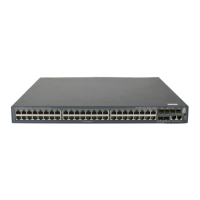41
To do… Use the command… Remarks
Enable the self-service server
location function and specify the
URL of the self-service server
self-service-url enable url-string
Optional
Disabled by default
Specify the default authorization
user profile
authorization-attribute
user-profile profile-name
Optional
By default, an ISP domain has no
default authorization user profile.
NOTE:
• For more information about user profiles, see the chapter “User profile configuration.”
• A self-service RADIUS server, such as Intelligent Management Center (iMC), is required for the
self-service server location function to work.
Configuring AAA authentication methods for an ISP domain
In AAA, authentication, authorization, and accounting are separate processes. Authentication refers to
the interactive authentication process of username/password/user information during an access or
service request. The authentication process does not send authorization information to a supplicant or
trigger accounting.
AAA supports the following authentication methods:
• No authentication (none)—All users are trusted and no authentication is performed. Generally, do
not use this method.
• Local authentication (local)—Authentication is performed by the NAS, which is configured with the
user information, including the usernames, passwords, and attributes. Local authentication allows
high speed and low cost, but the amount of information that can be stored is limited by the size of
the storage space..
• Remote authentication (scheme)—The NAS cooperates with a RADIUS, or HWTACACS server to
authenticate users. Remote authentication provides centralized information management, high
capacity, high reliability, and support for centralized authentication service for multiple NASs. You
can configure local or no authentication as the backup method, which will be used when the remote
server is not available. No authentication can only be configured for LAN users as the backup
method of remote authentication.
You can configure AAA authentication to work alone without authorization and accounting. By default,
an ISP domain uses the local authentication method.
Before configuring authentication methods, complete the following tasks:
• For RADIUS or HWTACACS authentication, configure the RADIUS or HWTACACS scheme to be
referenced first. The local and none authentication methods do not require a scheme.
• Determine the access type or service type to be configured. With AAA, you can configure an
authentication method for each access type and service type, limiting the authentication protocols
that can be used for access.
• Determine whether to configure an authentication method for all access types or service types.
Follow these steps to configure AAA authentication methods for an ISP domain:

